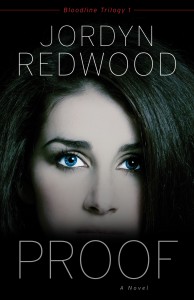Today’s guest blogger is Jordyn Redwood is a pediatric ER nurse by d ay, suspense novelist by night. Her debut medical thriller, Proof, examines the real life possibility of DNA testing setting a guilty criminal free. Here’s what she has to say on building tension.
ay, suspense novelist by night. Her debut medical thriller, Proof, examines the real life possibility of DNA testing setting a guilty criminal free. Here’s what she has to say on building tension.
Are you a lover of suspense novels? I know I am. I read and write them. There are many authors I admire but those I crave and anxiously anticipate their next novels are those that have so much tension on the page, you can barely keep the book in your hands without throwing is aside because you must read but can’t bear to read the next sentence.
That is perfection.
As a debut author myself, I want to create that experience for my readers. Tension. Angst. Worry.
Here are five tips to increase the tension in your suspense manuscripts. How many have you tried?
1. There must be death or danger of death in the first chapter: Recently, I reviewed a manuscript that’s major plot surrounded children being kidnapped. The first chapter had a father and son at an amusement park. The son goes missing for a short amount of time (maybe 1-2 hours) then is found and returned back to the father. Not a scratch on the child to be seen. Video showed that an employee took the boy somewhere he shouldn’t have. Hmm—okay. Nothing really too frightening is happening. How do I know it just wasn’t an employee being helpful when the boy lost sight of his father? Too slow. Particularly for suspense, the reader must be worried in the first chapter—first page is best. Most agents/editors make a decision about your ms after reading only the first page.
2. If you’re bored, the reader is falling asleep: If the passage you’re editing bores you as the author, use this as a signal to change the scene. Possibly, it needs to be outright discarded. Another option is to write the chapter in another POV. Bring in a character that can add conflict. Or, as James Scott Bell says—have someone walk in with a weapon.
3. Say what shouldn’t be said: For this, I’m not talking about vulgar language. In my second novel, I have two characters (Nathan and Lee) that were part of a hostage situation in my first nov el, Proof. It was one of my favorite scenes to write. In the second novel, these two are teamed up working a case. In Proof, Lee disagreed with Nathan about when SWAT should respond and people died. In the second book, Lee says, “Nathan, I don’t blame you for what happened.” Then I thought, why shouldn’t he blame him? Adds tension. Adds conflict. Adds dimension to their relationship. So—no more Mr. Nice guy and Lee let Nathan have it. Warranted or not. I love dialogue in fiction for this reason—you can say things that in real life you would normally stay mum about or gloss over in a PC way.
el, Proof. It was one of my favorite scenes to write. In the second novel, these two are teamed up working a case. In Proof, Lee disagreed with Nathan about when SWAT should respond and people died. In the second book, Lee says, “Nathan, I don’t blame you for what happened.” Then I thought, why shouldn’t he blame him? Adds tension. Adds conflict. Adds dimension to their relationship. So—no more Mr. Nice guy and Lee let Nathan have it. Warranted or not. I love dialogue in fiction for this reason—you can say things that in real life you would normally stay mum about or gloss over in a PC way.
4. Use descriptive elements to add spookiness. The challenge of the fiction author is to use your prose to engage all five senses in a way that will add tension for the reader. The master of descriptive, tense prose (in my opinion) is Dean Koontz. Here’s one example of his from The Moonlit Mind. “His breath plumes from him as if he’s exhaling ghosts.” I just love that. Does that not add to the tension? This also speaks to a concept that Donald Maass (his books on writing are a must read) teaches about called microtension. In a suspense novel, there’s the overall story arc of murder and mayhem. Microtension is ensuring that each sentence in the novel propels the reader forward to the point that they cannot set your novel down.
5. Make it look structurally pleasing: There are several techniques you can use in the structure of your novel that will quicken its pace. Short chapters. James Patterson is famous for this. But also, long sections of description will make suspense readers eyes gloss over. Shorter paragraphs interspersed with dialogue. Not every sentence of dialogue needs a tag as well.
What are some techniques you’ve used to increase the tension of your manuscripts?
You can read one of Jordyn’s favorite scenes from Chapter 2 of Proof by clicking here :
http://jordynredwood.net/resources/
and you can buy Proof on Amazon at: http://amzn.to/Lz06ut
And please leave a comment, or a “Like”. Thanks you. JRC

admiring the time and effort you put into your blog and detailed information you offer! lista de email
your posts are always so explicative, and i like it because i have a problem in understanding such things. mestreseo
I love your recommendation for a death in the first chapter. It always tells me I’m going to love a thriller’s pace when the danger is high from page 1.
One technique I use to build suspense in my work is keeping not only paragraphs and chapters short, but keeping sentences tight. Bulky sentences can be the death of pacing. If they’re bulky to read, chances are it’s slowing you down.
Good post.
Thank you, Colby and good tip!
Great information that I can share with my mystery writer friends and students. Thanks a lot!
Glad you are finding it helpful, Eileen!
Ann,
I know! Wish I would have thought of it first. High-five to the Koontz master!
Great interview. I’ve loved that line about exhaling ghosts too!!
I like short paragraphs as long as they are not choppy, but personally I’m not a fan of short chapters. To me chapter endings are like commercial breaks in TV–if they come too fast and frequently, I tune out. I want to stop reading at chapter endings. I guess the trick is to make the last sentence of each chapter as compelling as possible to make the reader continue. Thanks for posting.
Sally Carpenter
Interesting point, Sally.
Thank you, Jordan, for your excellent tips. To answer your question, I shorten my sentences in scenes where I want to increase tension. The shorter, clipped sentence structure adds a sharp staccato to the pacing and heightens the worry level. I’m eager to apply your suggestions. I especially like the one about saying what should not be said. Thanks again!
MaryAnn
Excellent point about using sentence fragments! I use them a lot too.
Love it. Great advice. I really like the very practical advice at the end too. I hate seeing a wall of words sometimes. It’s kind of like when I was in high school, reading my chemistry text book, and I’d flip the page to a page without a picture. Somehow that wall of words always forced me to take a break.
You don’t want your readers to do that!
John,
I once started reading Cold Mountain and after pages upon pages of prose– I couldn’t take it. Had to put it down. I’m sure it’s a fine novel but I needed a break from those walls of words.